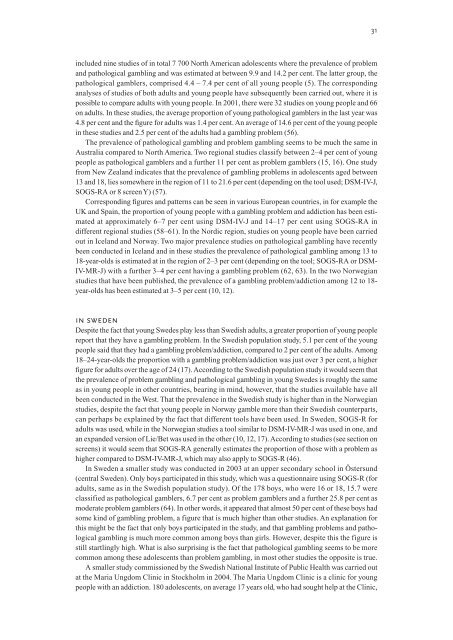Gambling Among Young People, 837 kB
Gambling Among Young People, 837 kB
Gambling Among Young People, 837 kB
Create successful ePaper yourself
Turn your PDF publications into a flip-book with our unique Google optimized e-Paper software.
included nine studies of in total 7 700 North American adolescents where the prevalence of problem<br />
and pathological gambling and was estimated at between 9.9 and 14.2 per cent. The latter group, the<br />
pathological gamblers, comprised 4.4 – 7.4 per cent of all young people (5). The corresponding<br />
analyses of studies of both adults and young people have subsequently been carried out, where it is<br />
possible to compare adults with young people. In 2001, there were 32 studies on young people and 66<br />
on adults. In these studies, the average proportion of young pathological gamblers in the last year was<br />
4.8 per cent and the figure for adults was 1.4 per cent. An average of 14.6 per cent of the young people<br />
in these studies and 2.5 per cent of the adults had a gambling problem (56).<br />
The prevalence of pathological gambling and problem gambling seems to be much the same in<br />
Australia compared to North America. Two regional studies classify between 2–4 per cent of young<br />
people as pathological gamblers and a further 11 per cent as problem gamblers (15, 16). One study<br />
from New Zealand indicates that the prevalence of gambling problems in adolescents aged between<br />
13 and 18, lies somewhere in the region of 11 to 21.6 per cent (depending on the tool used; DSM-IV-J,<br />
SOGS-RA or 8 screen Y) (57).<br />
Corresponding figures and patterns can be seen in various European countries, in for example the<br />
UK and Spain, the proportion of young people with a gambling problem and addiction has been estimated<br />
at approximately 6–7 per cent using DSM-IV-J and 14–17 per cent using SOGS-RA in<br />
different regional studies (58–61). In the Nordic region, studies on young people have been carried<br />
out in Iceland and Norway. Two major prevalence studies on pathological gambling have recently<br />
been conducted in Iceland and in these studies the prevalence of pathological gambling among 13 to<br />
18-year-olds is estimated at in the region of 2–3 per cent (depending on the tool; SOGS-RA or DSM-<br />
IV-MR-J) with a further 3–4 per cent having a gambling problem (62, 63). In the two Norwegian<br />
studies that have been published, the prevalence of a gambling problem/addiction among 12 to 18year-olds<br />
has been estimated at 3–5 per cent (10, 12).<br />
in sweden<br />
Despite the fact that young Swedes play less than Swedish adults, a greater proportion of young people<br />
report that they have a gambling problem. In the Swedish population study, 5.1 per cent of the young<br />
people said that they had a gambling problem/addiction, compared to 2 per cent of the adults. <strong>Among</strong><br />
18–24-year-olds the proportion with a gambling problem/addiction was just over 3 per cent, a higher<br />
figure for adults over the age of 24 (17). According to the Swedish population study it would seem that<br />
the prevalence of problem gambling and pathological gambling in young Swedes is roughly the same<br />
as in young people in other countries, bearing in mind, however, that the studies available have all<br />
been conducted in the West. That the prevalence in the Swedish study is higher than in the Norwegian<br />
studies, despite the fact that young people in Norway gamble more than their Swedish counterparts,<br />
can perhaps be explained by the fact that different tools have been used. In Sweden, SOGS-R for<br />
adults was used, while in the Norwegian studies a tool similar to DSM-IV-MR-J was used in one, and<br />
an expanded version of Lie/Bet was used in the other (10, 12, 17). According to studies (see section on<br />
screens) it would seem that SOGS-RA generally estimates the proportion of those with a problem as<br />
higher compared to DSM-IV-MR-J, which may also apply to SOGS-R (46).<br />
In Sweden a smaller study was conducted in 2003 at an upper secondary school in Östersund<br />
(central Sweden). Only boys participated in this study, which was a questionnaire using SOGS-R (for<br />
adults, same as in the Swedish population study). Of the 178 boys, who were 16 or 18, 15.7 were<br />
classified as pathological gamblers, 6.7 per cent as problem gamblers and a further 25.8 per cent as<br />
moderate problem gamblers (64). In other words, it appeared that almost 50 per cent of these boys had<br />
some kind of gambling problem, a figure that is much higher than other studies. An explanation for<br />
this might be the fact that only boys participated in the study, and that gambling problems and pathological<br />
gambling is much more common among boys than girls. However, despite this the figure is<br />
still startlingly high. What is also surprising is the fact that pathological gambling seems to be more<br />
common among these adolescents than problem gambling, in most other studies the opposite is true.<br />
A smaller study commissioned by the Swedish National Institute of Public Health was carried out<br />
at the Maria Ungdom Clinic in Stockholm in 2004. The Maria Ungdom Clinic is a clinic for young<br />
people with an addiction. 180 adolescents, on average 17 years old, who had sought help at the Clinic,<br />
31

















